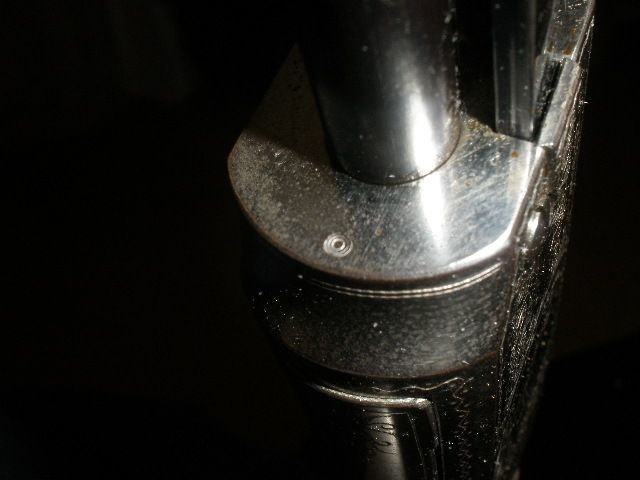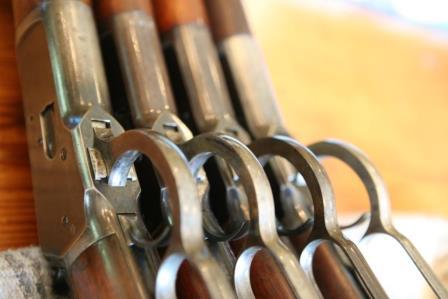HI,
I’m new to this forum but have been reading for quite a while. I have a .22 short, 2nd Model 1890 made in 1898. The front of the receiver just under the magazine has a stamp that has a circle with a circle inside and another circle inside that one. In other words it looks like a target. Does anyone know what that stamp is? I can’t find any information on that type of stamp. Thanks for any help.
Len B
hello again 66m20e: The rifle appears just a bit more classy than a standard Mo 1890. Plus you have a factory letter. Etc. You may be holding out on us by not posting more photos.
From what I observe in your photo, the concentric circles appear to be more "engraved" than a stamp. Your rifle appears to be engraved, I assume factory engraved. There could be a connection?
Merrill
I may be completely wrong, but I "think" I have seen this same marking on one of my 1894s or 55s. It sure looks familiar. Don’t have time to pull them a ll apart right now though, but if I recall, it may have been on one of the more recent rifles I picked up. I will take a look when I can, I have to go into work this evening.
Matt
Thanks for the photo.
I’ve never seen reference for this stamp which I agree looks more like engraving. If someone believes it to be a factory stamp then please provide reference.
Otherwise, I think it might be the engraver’s touch. What is shown of the engraving doesn’t look to be factory…
Can you provide some closeups of the engraving over the entire receiver and one of what the museum letter reports?
ohlode said
Thanks for the photo.I’ve never seen reference for this stamp which I agree looks more like engraving. If someone believes it to be a factory stamp then please provide reference.
Otherwise, I think it might be the engraver’s touch. What is shown of the engraving doesn’t look to be factory…
Can you provide some closeups of the engraving over the entire receiver and one of what the museum letter reports?
ohlode,
See pages 55, 56, & 57 of Winchester Slide Action Rifles Vol. 1, for explanation and pictures. I’ve seen the bullseye stamping on numerous model 1890-90 rifles in .22 WRF caliber over the years, but I don’t ever recall seeing it on any other caliber.
James
Good eye JWM. Page 56 of Vol. I nails it, when Schwing says "Some of these symbol stampings will be made up of two concentric circles or a triangle with the numeral 1 in the center, or other odd looking characters."
So Len, the concentric circles on your .22 short is an inspection stamp.
By the way the following page does show the concentric circles on the inside of the lower tang with the W.R.F. stamping. But I believe this is a coincidence, rather than the rule. and only on the early first and second models.
Good post Len.
WOW! The mystery of the stamp solved at last. I was looking a long time for the answer. Thank you everyone for all your help and especially taking the time to research the issue. Great forum and I can see a real dedicated group of Winchester collectors willing to share their knowledge.
Len
ohlode said
Thanks for the photo.I’ve never seen reference for this stamp which I agree looks more like engraving. If someone believes it to be a factory stamp then please provide reference.
Otherwise, I think it might be the engraver’s touch. What is shown of the engraving doesn’t look to be factory…
Can you provide some closeups of the engraving over the entire receiver and one of what the museum letter reports?
ohlode,
See pages 55, 56, & 57 of Winchester Slide Action Rifles Vol. 1, for explanation and pictures. I’ve seen the bullseye stamping on numerous model 1890-90 rifles in .22 WRF caliber over the years, but I don’t ever recall seeing it on any other caliber.
James
Thanks, James! Great information. Don’t want to take this too much further but…
Inspection stamp indicating what exactly?
Was it a particular inspector or just a indication that it was "inspected". Sorry for my lack of knowledge but I’m here to learn.
James: Yes, that’s an interesting possibility. I would think it was specific either to an individual inspector or a particular inspection, special meaning, etc., etc.. Someone at that factory knew exactly what that stamp meant… I was actually pondering the possibility that it signified a replacement inner and outer mag tube. I like your theory better. Anyone else know or want to contribute thoughts?
ohlode said
James: Yes, that’s an interesting possibility. I would think it was specific either to an individual inspector or a particular inspection, special meaning, etc., etc.. Someone at that factory knew exactly what that stamp meant… I was actually pondering the possibility that it signified a replacement inner and outer mag tube. I like your theory better. Anyone else know or want to contribute thoughts?
ohlode,
Now that’s an interesting thought too. Thanks for your comments.
Carrying the target-idea a bit further, it would appear that of the following three calibers, .22 Short, .22 Long, and .22 WRF, the .22 Short would have been the favorite one for professional trick shooters, while the .22 WRF would seem to me to have been the favorite one for long range target shooting and or hunting. Schwing explains in his book that sights on the 1890 were set at 25 yards, but Winchester would set them at different ranges for their customers on request. The examples given were from 25 feet up to 200 yards, and if memory serves me right Ad Topperwein had his set at 25 feet. Schwing also points out that one customer requested the sights to be set at 100 feet on his .22 Short, which was equipped with a special target front sight and a mid-range tang sight. With this information and scenario in mind, wouldn’t you think that Winchester might have had an inspector to make a mark like the bulls-eye to affirm that such requests had been processed?
1 Guest(s)


 Log In
Log In Members
Members Home
Home

 Add Reply
Add Reply Add Topic
Add Topic
 Offline
Offline







